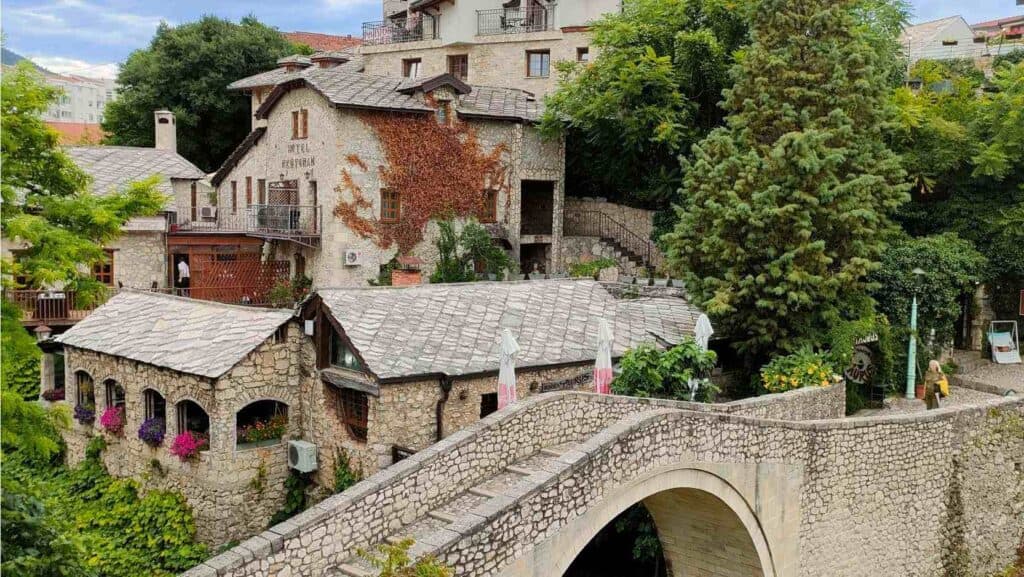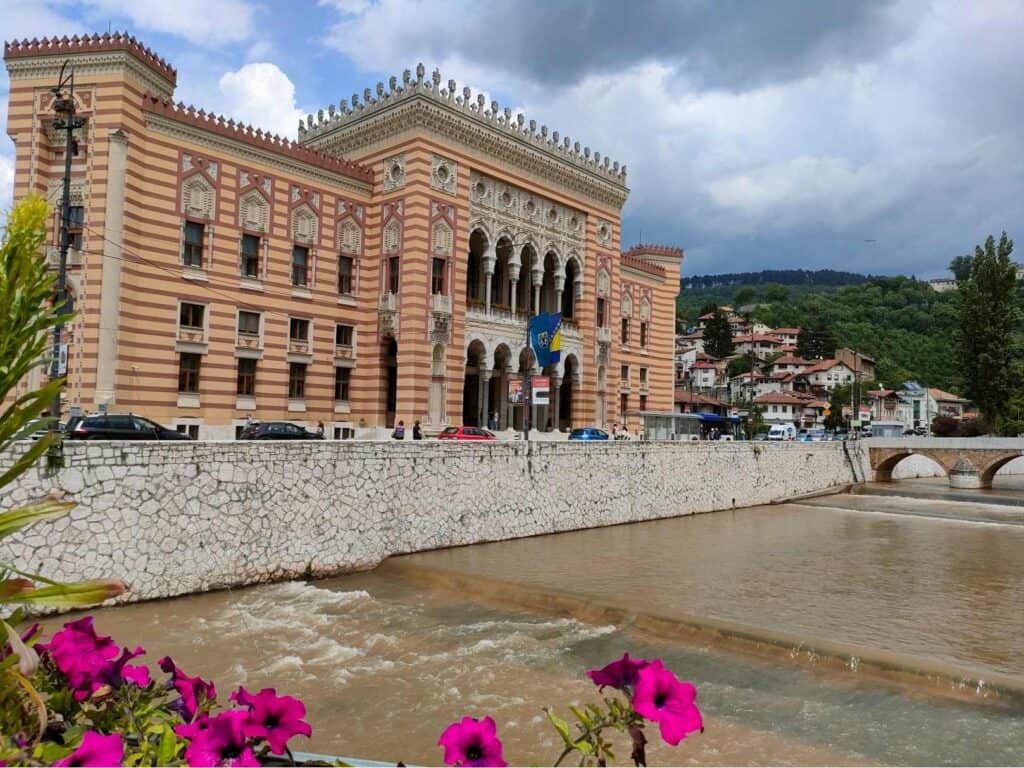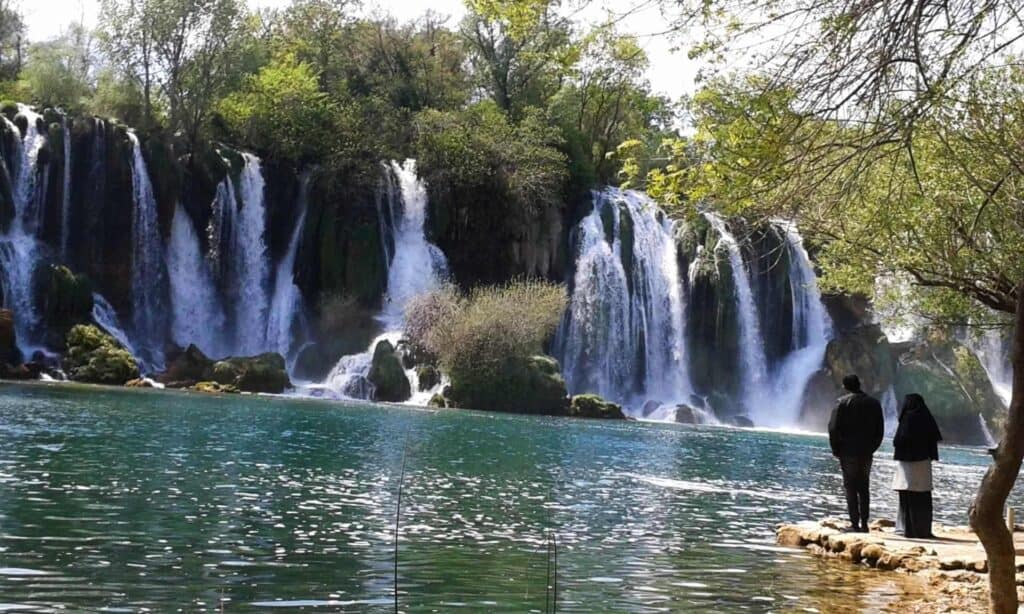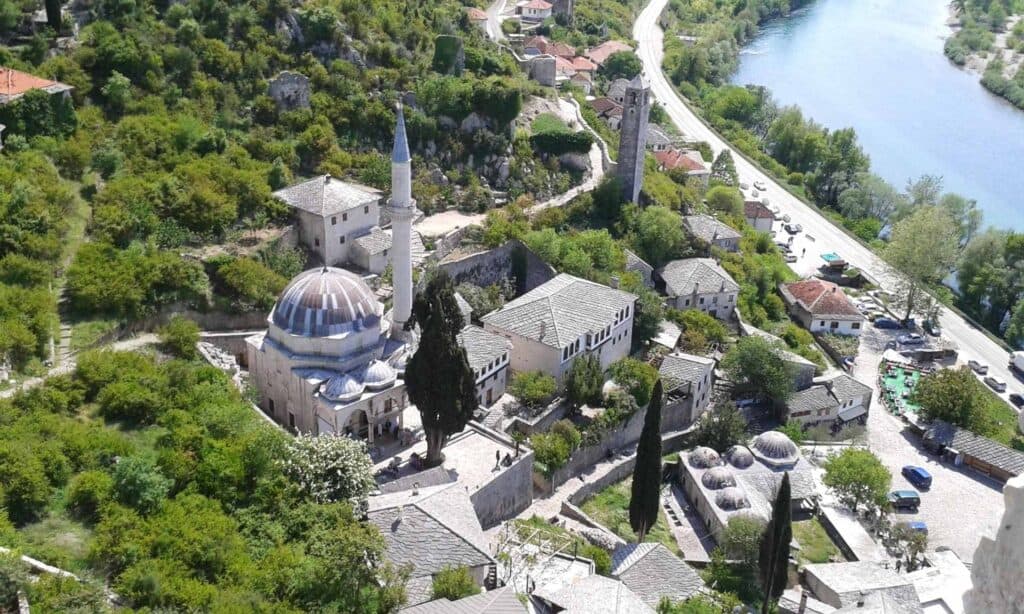This article may contain affiliate / compensated links. For full information, please see our disclaimer here.
Mostar is probably the most popular city in Bosnia and Herzegovina among tourists that everybody includes in their itinerary. The old city is UNESCO World Heritage that was extensively destroyed during the Balkan war, but reconstructed from the original materials and techniques. The Old Bridge that collapsed during the Bosnian war is the highlight, but there are other things to do in Mostar. While most tourists make only a short visit or a day trip to Mostar from Dubrovnik or Sarajevo, you can only know the best side of the city if you stay overnight when it becomes calm and relatively empty of tourists. This detailed travel guide includes the best things to do in Mostar.
Ultimate travel guide to Bosnia and Herzegovina+ itinerary
- Day trip from Sarajevo to Mostar
- Day trip from Split/Dubrovnik to Mostar
- What you should know before traveling to Mostar
- How to plan your trip to Bosnia and Herzegovina
- Local tours in Mostar – the best way to visit the city
- Where to stay in Mostar?
- One day Mostar itinerary
- Other posts about Bosnia and Herzegovina
Day trip from Sarajevo to Mostar
You can make a day trip from Sarajevo to Mostar; however, if you have time, as I mentioned recommend staying overnight.
You have 3 options: take an organized tour, go by bus or train.
Sarajevo 1 day, 2 days and 3 days itinerary
By train:
The train is the best option to go from Sarajevo as it the cheap, comfortable, clean, and fast. In only two hours, you get to Mostar. Take the train at 7: 15 in the morning. Check the timetable here. You don’t have other options as there are only a few trains a day. It costs 14 KM (~7 EUR).
To return from Mostar, you have two 17:09 and 19:56
By bus:
There are more buses a day from Sarajevo, but if you want to use the day, better you take the one at 6 am or 9am. To return from Mostar, you can take it at 6.15pm or 7.10pm. The journey takes almost 2 and a half hours each way. One ticket costs around 12-14 EUR. If you book a return ticket, it will be cheaper than buying your tickets separately.
You can book your bus ticket here and here
Organized tour:
Organized day trips from Sarajevo with a tour guide are a great way to learn more about Mostar.
Day trip from Split/Dubrovnik to Mostar
There is no train between Split/Dubrovnik and Mostar, your only option is to take a bus, and the bus trips take around 4 hours, so it is something you should consider if it is worth doing for a couple of hours to be able to stay in Mostar and spending 8 hours in the bus.
You can book your bus ticket here and here
Book a trip to Mostar from Split/Dubrovnik
What you should know before traveling to Mostar
Since Mostar is the main city in the geographical region of Herzegovina, they are especially sensitive to that if you talk about the country simply as Bosnia. Always try to use the full name Bosnia and Herzegovina.
Mostar was an irrelevant city before the arrival of the Turks. But the fertile valley was an ideal place to build a city. Mostar’s name means “bridge keeper,” after those who guarded the bridge during the Ottoman era. The Old Bridge (Stari Most), spanning over the Neretva River, has always been the soul and symbol of the city. So when it exploded after 427 years during the Bosnian war, it was a pure tragedy.
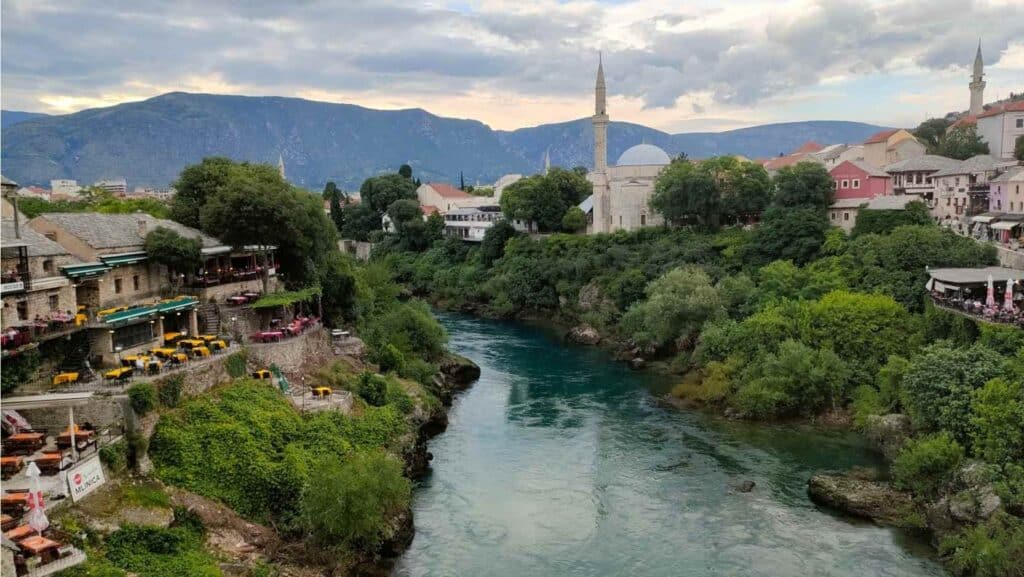
On each side of the Old Bridge, the cobbled streets from the Ottoman period have always been the traders’ quarter, where several tanners and goldsmiths settled. Mostar was a key transportation hub within the Ottoman Empire. Beautiful mosques and madrasas (religious schools) were built in the 16th and 17th centuries when Islam spread among the residents. Muslims enjoyed more freedoms and tax breaks, but Christian communities also enjoyed a relatively high level of tolerance by the Turks, particularly in the first two centuries of rule. Since the Ottoman era, Mostar has been Herzegovina’s political, cultural and economic backbone.
Later, the Austro-Hungarian occupation also left its marks on the outskirts of the old town with Viennese-style architecture.
After WWII, Mostar became a major socialist stronghold in Yugoslavia and a prosperous industrial center (aluminum, chemical, and food industries). Workers were transported by 50 buses a day, and the population multiplied.
The Bosnian war (1192-1995) destroyed 90% of the buildings; Mostar was among the most war-affected places in the country. The war-damaged buildings in the center are a constant reminder of the dark past.
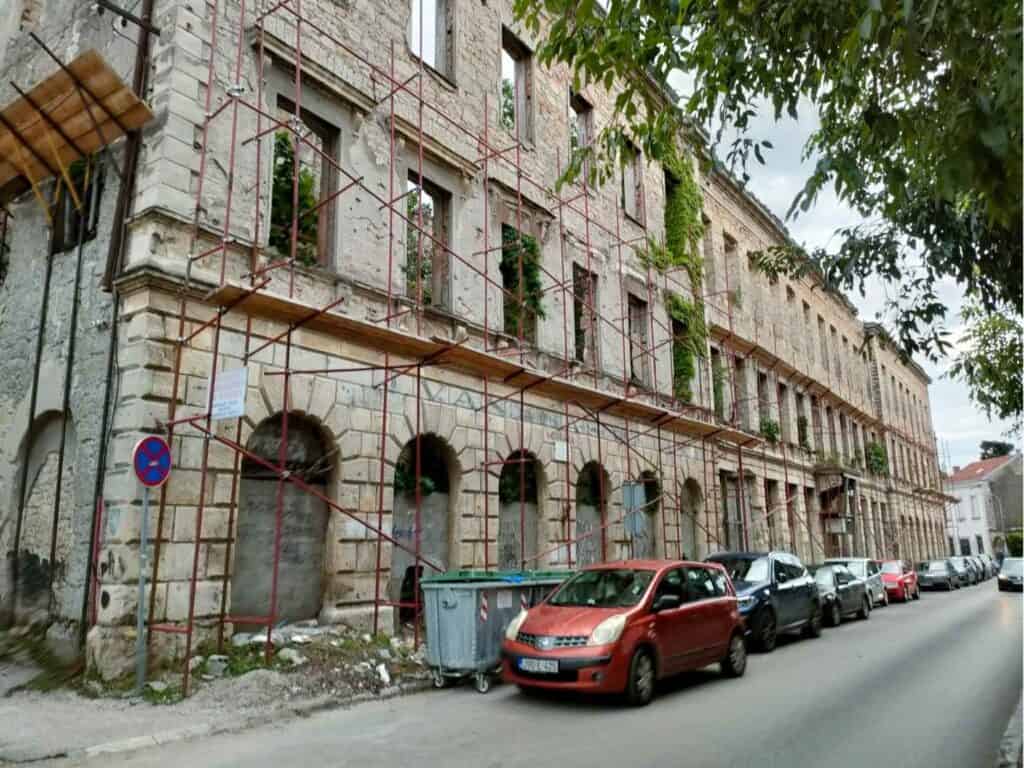
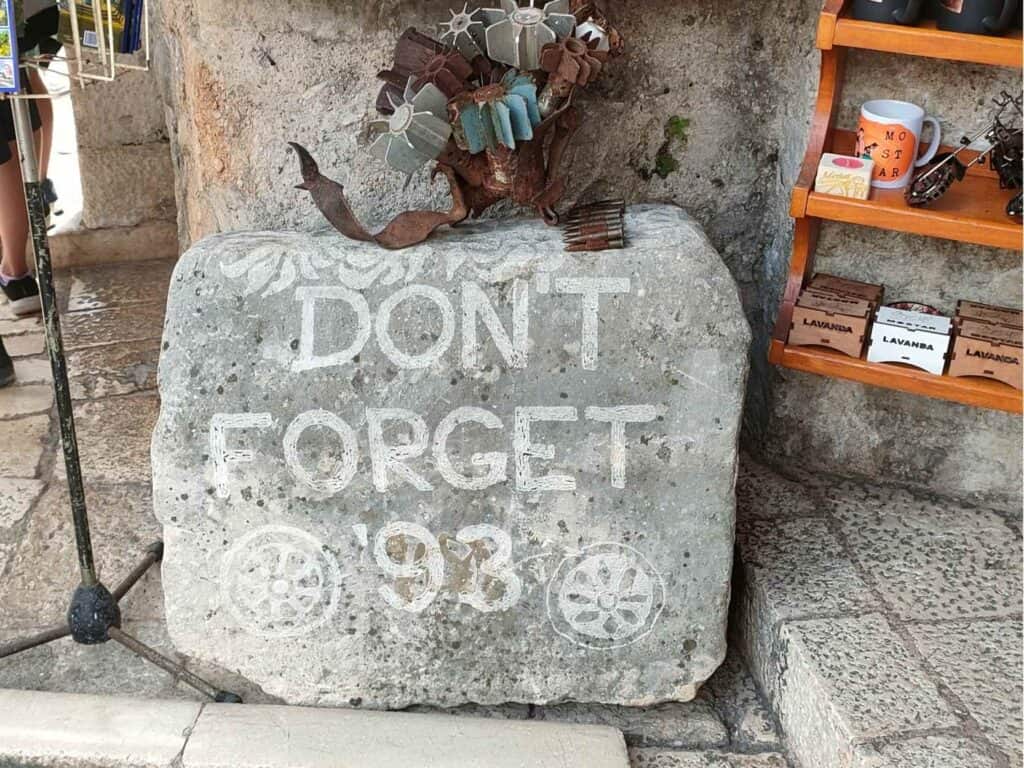
The situation in Mostar was quite different from that in Sarajevo. There were two war periods in Mostar. In 1992, between April and June, Bosnian and Croatian troops fought together against the Serb-dominated Yugoslav army. Many buildings and monuments were destroyed, and 90,000 people fled Mostar. However, the war took a turn, and the previously allied Croats and Bosniaks turned against each other between June 1993 and April 1994 after it was revealed that the Serbian and Croatian presidents had secretly agreed on the partition of Bosnia and Herzegovina. On 9th November, the iconic Old Bridge collapsed into the Neretva River, revealing the war’s cruelty and hopelessness.
After two years of bombings, by 1995, Mostar looked like Dresden after World War II. All its bridges were destroyed, and one out of 27 mosques remained intact.
The Washington Accords in March 1994 ended the war between Bosnian Croats and Bosniaks, in which two thousand people died. Since then, Mostar has been divided into two parts based on ethnicity. Croats live in the western part of the city, and Bosnians live in the eastern part. Serbs fled the city during the war. The two ethnic groups have a separate school, post office, electricity and telephone provider, and bus station. Many Croatians have never crossed the Old Bridge.
It is hard to understand how it could happen in a city that, prior to the war, had one of the most balanced and multi-ethnic populations in former Yugoslavia. The people here identified themselves with the town, not their national or ethnic background – they were Mostarci or Mostarians.
Many true Mostarians are now refugees in Europe and America, discouraged from returning to a divided city.
How to plan your trip to Bosnia and Herzegovina
Flight: Find the cheapest flights to Bosnia and Herzegovina with Skyscanner or book flights, hotels, and local tours, rent a car, and benefit from immediate cashback through Wayaway! You can sign up for the Wayaway Membership program for only 49.99$! Use my discount code to get extra 10% off the subscription fee: VOG
Accommodation: Book hostels through hostelworld.com or look for both hostels and hotels in Bosnia and Herzegovina on booking.com.
Local tours: Book walking tours in tours in Sarajevo, Mostar and other one or multi-day trips in Bosnia-Herzegovina through GetYourGuide or Viator
Rent a car: Find a great deal to rent a car with Discover Cars or Rentalcars.
Bus ticket: Book your bus ticket through Bookaway in Bosnia and Herzegovina.
Local tours in Mostar – the best way to visit the city
I highly recommend taking a walking tour with a guide in Mostar that gives you a better understanding of the place. On the surface, Mostar is a charming city with picturesque restaurants and cobblestoned streets that is nice to stroll around and take stunning photos at the Old Bridge. However, if you want to learn more about Yugoslavia, the frontline, and current life in Mostar besides the attractions, a 3-hour-long walking tour helps you get the full picture of the place.
I participated in two local tours, and both were one of the most memorable parts of my trip to Bosnia and Herzegovina.
Death of Yugoslavia
This is not about the attractions of the Old City. You partly leave Mostar to visit a secret military base that could accommodate 100 aircraft, an example of Yugoslav paranoia. You will hear about how people lived under the leadership of Josip Broz Tito and about war times. This tour is not about picturesque places but about understanding recent history. This is a must-do in Mostar!
Walking tour with Sheva
You will visit the important attractions of the Old City, coppersmith shops, and famous mosques, get recommendations for photo spots and local food, but also a deep explanation about Yugoslav times, and you will walk to the former frontline that divided the city between the Bosnian Croats and Bosniaks.
Being a tour guide, I was impressed by the style and knowledge of Sheva.
I highly recommend both tours.
Mostar Traditional Lunch or Dinner Cooking Class
It is a perfect program if you are interested in Bosnian cuisine and want to learn how to make that while spending time with locals.
Break-up of Yugoslavia & The War in Mostar: Life Under Siege
This tour focuses on life during the Bosnian war in Mostar, guided by somebody who lived through the war. It includes visiting ruins, bunkers, and other places and painful stories that help you understand the hard times that lasted for years.
Where to stay in Mostar?
Low-budget
Pansion Oscar Summer Garden (booking.com review: 8.5)
This is probably the best low-cost accommodation with a lovely common terrace, a shared fully equipped kitchen, a cocktail bar with narghile, and a restaurant on the spot. A great place to make friends if you travel alone, even if you are a couple.
TIRYAKI (booking review: 9.3)
Each apartment in the centrally located guesthouse offers a terrace with a mountain view and a private parking space. It is ideal if you are looking for something affordable without worrying about where to park your car. Bicycle and car rentals are both available on the spot.
Mid-range
Elegant Studio Apartments Lasta (booking review: 9.9!)
The stylish modern apartments have a perfect location a few hundred meters from the Old Bridge, and the best thing is that you can enjoy a view of the city from the rooftop terrace. It will definitely make your stay memorable!
Urban Residence Apartments (booking review: 9.4)
The modern apartment is within a short walk from the Old Bridge. It is spacious with a kitchen, a dining table, and a sofa—a perfect place for couples.
Residence Riverside (booking.com review: 9.5)
Only 130meter from the old bridge, each apartment has a seating area and a balcony, plus car and bicycle rentals are both available in the house (review 9.5)
Villa Hodžić (bookng.com review: 9.5)
700 meters from the Old Bridge, this modern apartment is perfect for couples and families, with kitchen fully equipped kitchen with a fridge and a dishwasher, a terrace, and a seating area
Bosnian National Monument Muslibegovic House (booking.com review 9.3)
If you are looking for something unique in the heart of the city, this hotel is inside a renovated historic building directly in the Old City. The rooms have individual Ottoman-Bosnian designs with antiques, and the adjacent garden has roses and palm trees.
High-end
Hotel Mepas: (booking.com review 9.2)
The hotel is part of a shopping center with a cinema, caffés and bars, shops, a bank, an exchange office, a hair salon, a children’s playroom, and a bowling center. The hotel is located 1.5 km from Old Bridge Mostar and has a pool and a wellness department. It is perfect for families.
Hotel Eden (booking.com review 8.4)
Only 5 minutes walk from downtown; this hotel has all the amenities you need: a restaurant that serves Herzegovinian dishes prepared with local ingredients and a wide range of local and international wine. The spa area has a swimming pool, sauna, Turkish bath, and gym. A perfect place to rest once you are back in your hotel.
One day Mostar itinerary
The Old Town
Most attractions are in the old city, a UNESCO World Heritage. As mentioned before, a big part of the old city was destroyed but reconstructed in the same Ottoman style.
Here you find the crooked bridge (Kriva ćuprija), the oldest single-arch bridge in Mostar, completed 10 years before the Old Bridge, which looks to be a smaller version of the famous one built around 1558. It is also a reconstruction as it was destroyed by the flood in 2001.
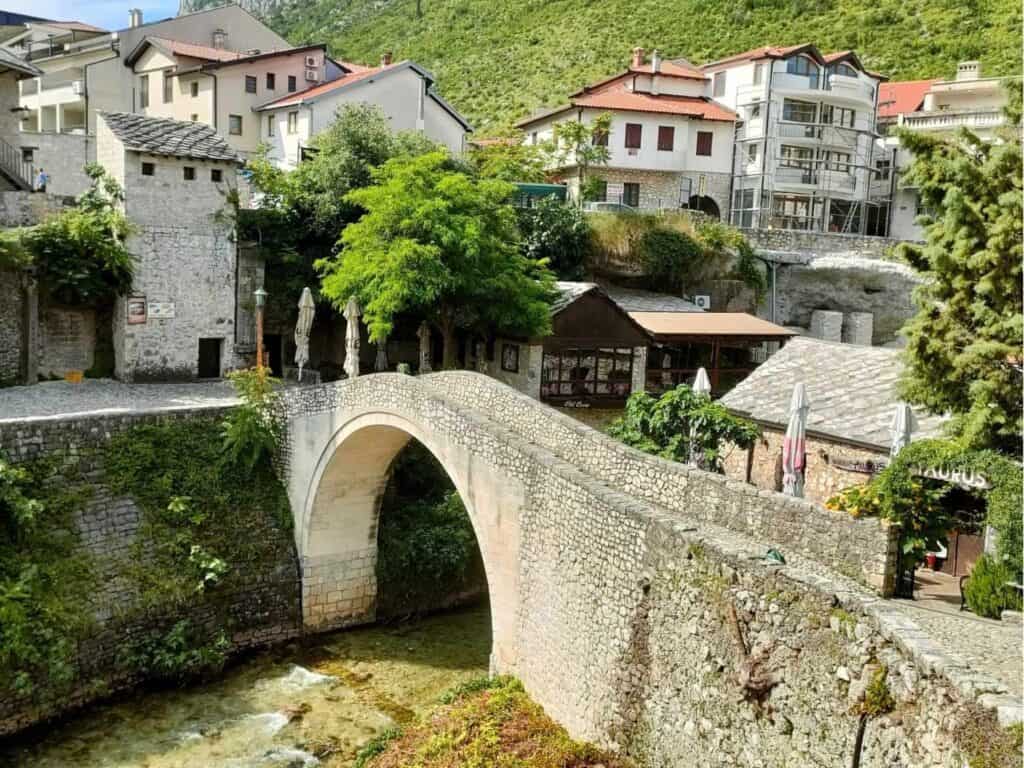
A popular place on the west side is Tabhana, the former Turkish bath, the courtyard of which has a couple of restaurants and cafés as well as further down the entire river bank with one of the best views to the Old Bridge.
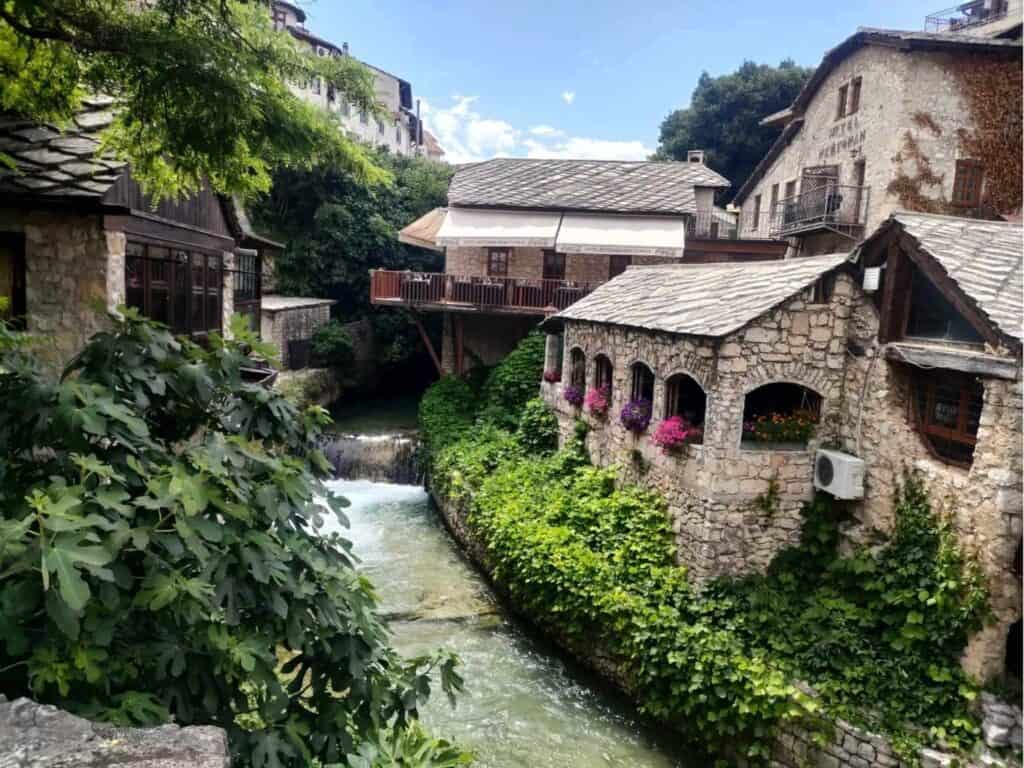
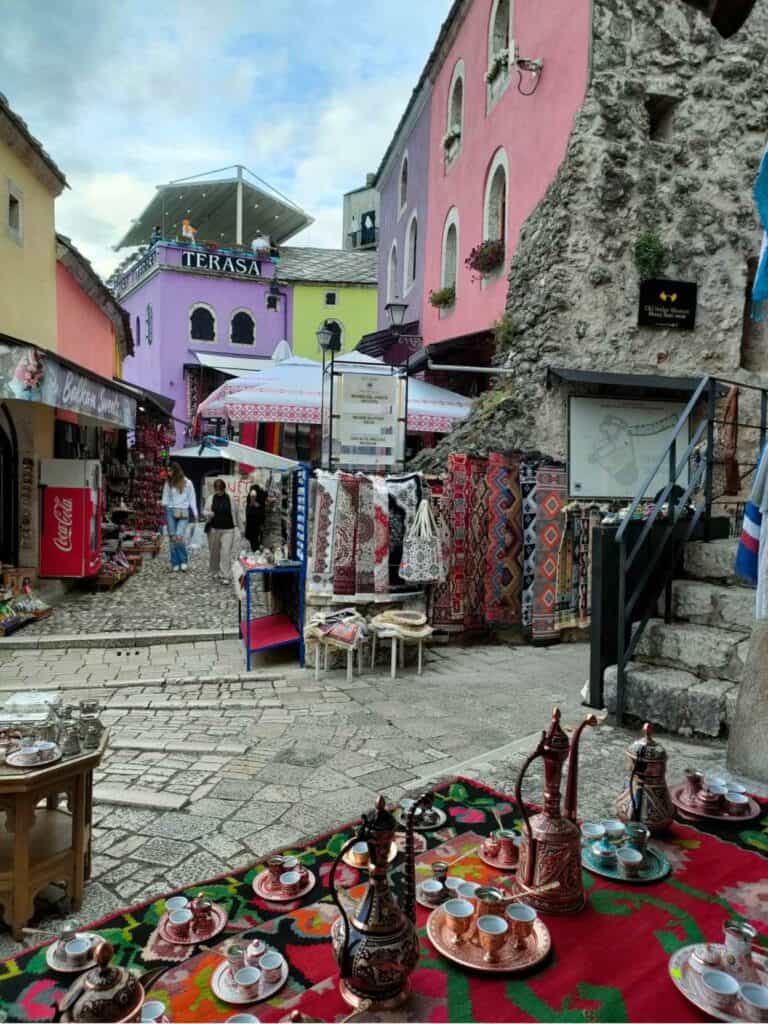
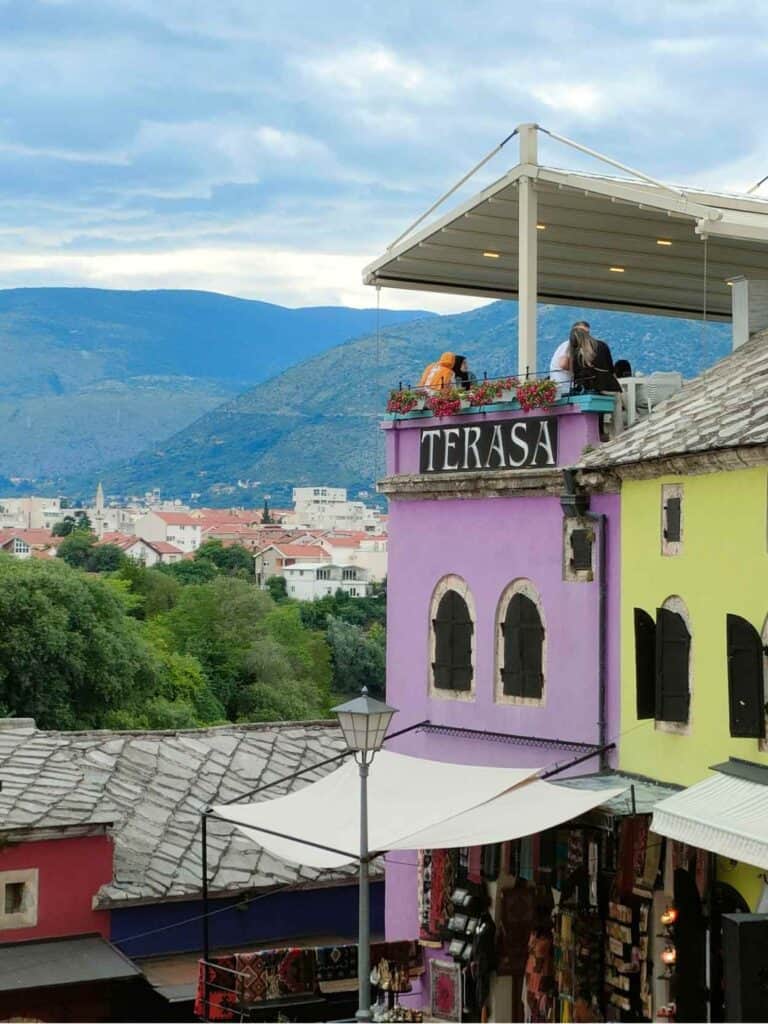
The Old Bridge (Stari most)
Suleiman the Great ordered the construction of a stone bridge instead of the previous suspension bridge in 1557 after nine years of construction to replace the former wooden bridge, which was terrifying for merchants to cross over the fast-flowing Neretva River. The famous Old Bridge (Stari Most) was completed in 1566 and was considered one of the engineering marvels of its time. It survived the Italian occupation during World War II, but after 427 years of existence, it was blown up by Bosnian Croat artillery in November 1993. It was one of the most shocking and painful moments of the entire Yugoslav war. This marked the end of the unity of the people of Mostar, which has since been divided between the ethnic groups.
Until it was rebuilt in 2004 with international support, a wooden bridge replaced the original. It was an enormous challenge as the pieces recovered from the water years after became unusable. The relatively soft stone eroded, and the metal connection rusted, creating cracks.
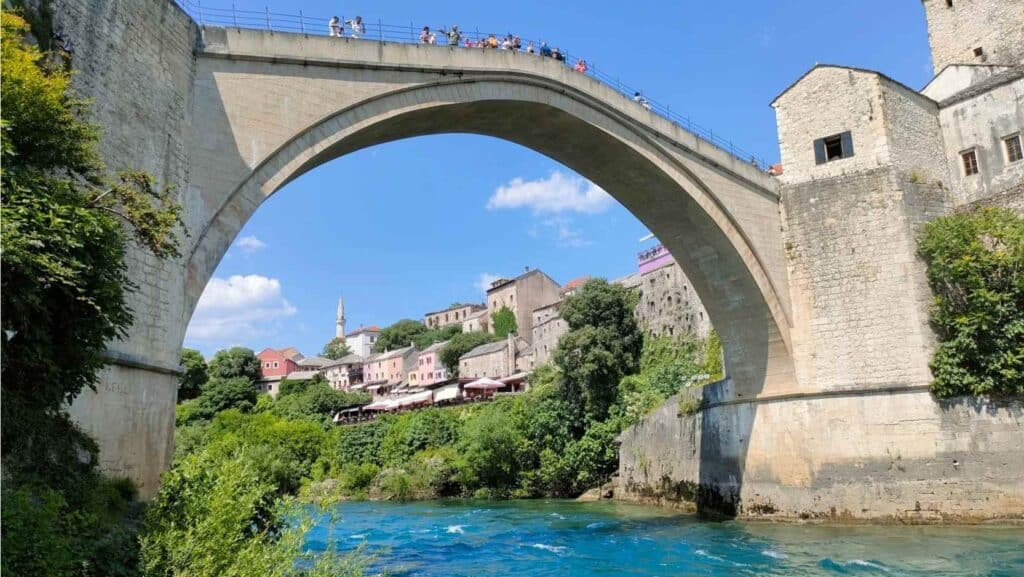
The inauguration was broadcasted by several international media outlets, showing its significance.
The annual diving competition takes place every year in July, which could add to your experience in Mostar when young people from BiH and other ex-Yugoslavian countries jump off the 21-meter-high bridge. And it is nothing new; it has a long tradition in Mostar. Even before the war, it was not a real man who hadn’t plunged off the bridge at least once.
Locals also jump for some tips for the entertainment of tourists at any time. The diver stands at the highest point of the bridge and waits until enough money is collected. Moreover, anybody can undertake the jump after a short training and proof of experience. Contact the divers’ club at the foot of the bridge. But don’t do that without permission, as it can be dangerous.
The best view of the Old Bridge
In Mostar, you can’t help taking countless photos of the Old Bridge from every possible angle. So I summed up some of the best viewpoints of the Old Bridge and Mostar.
– The Neretva riverbank at the foot of the Old Bridge, where the motorboats depart, is the best!
– You can take this motorboat around and take photos from the boat
– The minaret of the Koski Mehmed-Pasha Mosque (8KM~4EUR)
– The backside of the Koski Mehmed-Pasha Mosque that tourists often miss; you just need to walk around
– Excellent view from Lučki Bridge (one bridge after the Old Bridge)
– The Kujundžiluk street, where the coppersmith shops are, as the road ascends, you have a great view of the Old Bridge
– Have a drink with a panoramic view in Bijeli bar, Café Terasa, Café Bridge (in the tower at the foot of the bridge ), or Café Karma
– Have lunch/dinner with a panoramic view: Urban Grill, Ćevabdžinica Košćela, Restaurant Babilon, Restaurant Labirint
From here, you have an excellent view of Mostar but not the Old Bridge:
– The 107-meter-high bell tower of the Catholic Church of St. Peter and Paul (6KM~3EUR) offers a great view of the city but not the Old Bridge
– Skywalk in Fortica Park is a new attraction, a 35-meter-long transparent walkway with a view of Mostar
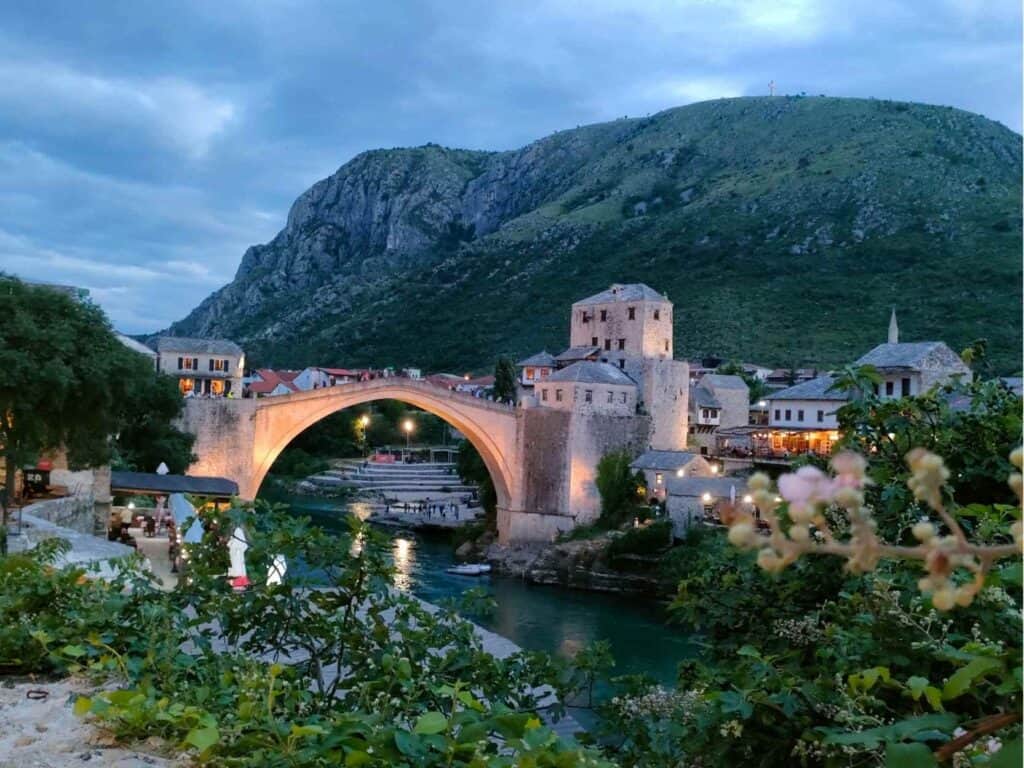
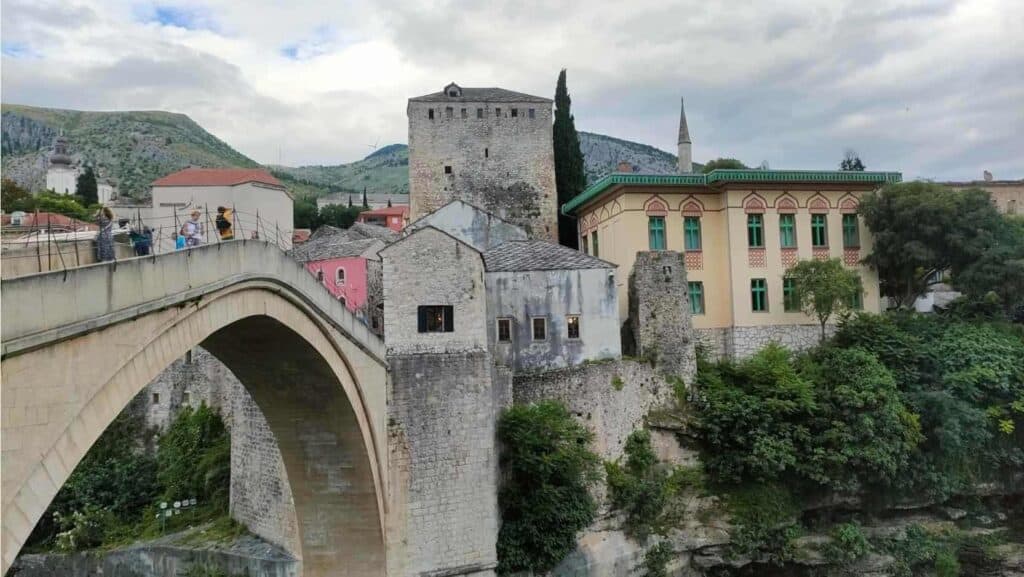
The towers on each side of the Bridge served to guard the crossings over it and had a dungeon and a gunpowder store as well. The one on the west side houses the Bridge Divers’ Club. Just above, there is a small exhibition with 50 photos taken by Wade Goddard, a New Zealand photojournalist during the war (entrance fee: 6KM ~3EUR)
There is a War Photo Exhibition in one of the shops at the foot of the bridge. The entrance fee is 10 KM (5 EUR)
Located just above the Bridge Divers’ Club, this small exhibition houses a collection of 50 powerful photos taken by Wade Goddard during the 1992–95 war.
In the Tara Tower, you can visit the Stari Most museum about the history of the Old Bridge.
Opening hours: 09:00- 17:00
Entrance fee: 10 KM (5 EUR)
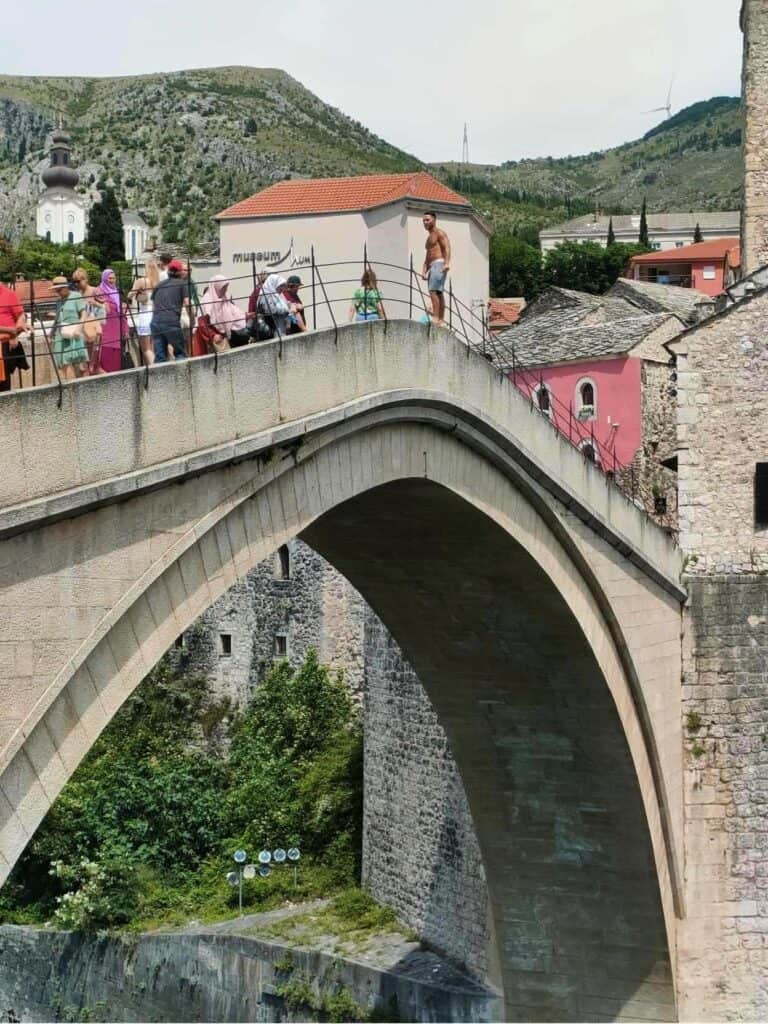
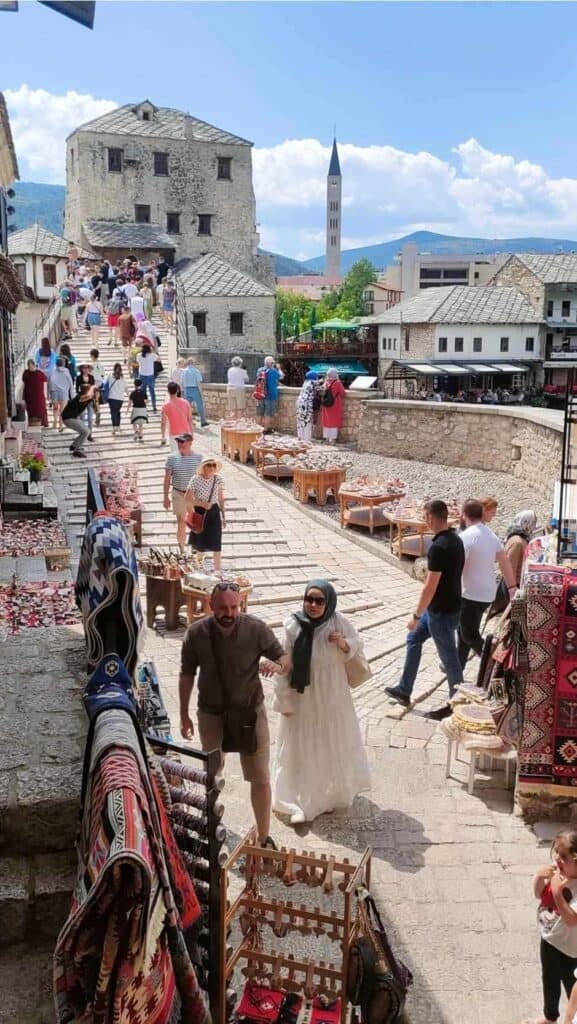
The cobbled street on the east side is Kujundžiluk, where traditionally, coppersmiths have their shops. You can still observe how they hammer the copper in some of them. Be aware that many sell Chinese products. (look for BADZAK 1918, which sells handmade crafts for generations).
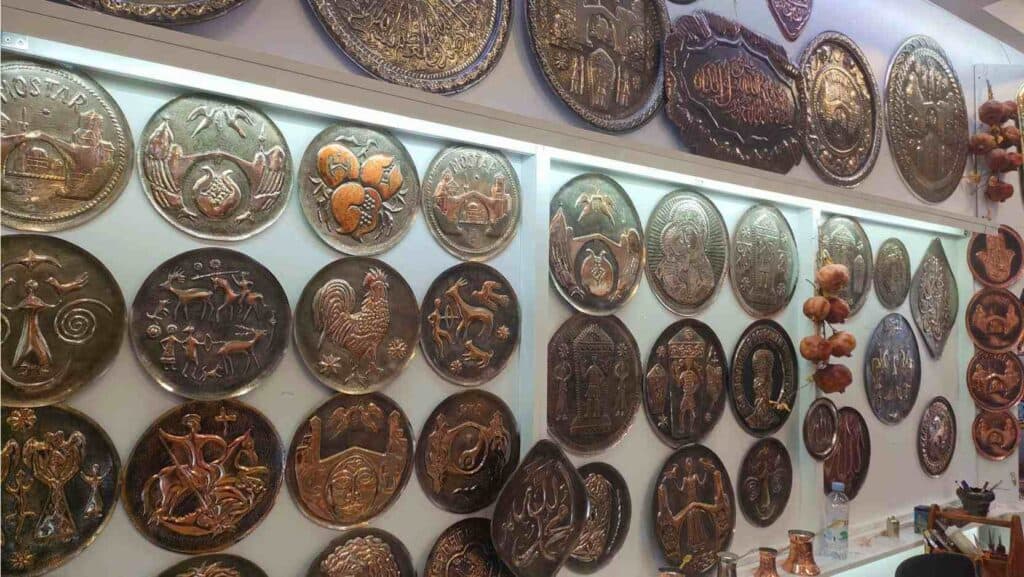
After Kujundžiluk, head to one of the famous mosques, the Koski Mehmed-Pasha Mosque, with a pleasant courtyard. Visiting the mosque decorated with wood carvings and paintings is free, but it costs 8 KM (4KM) to go up the tower for a nice view of the city. This is the one that you see standing on a cliff from the Old Bridge. It has a similar style to the Karadzoz Beg Mosque, which probably served as a model to it. The mosque was founded by Mehmed Koskija, the biographer of the Grand Vizier Lala Mehmud Sokovic in the 17th century. The beautiful interior of the mosque has painted wall murals and an impressive carpet that was a gift from Austrian monarch Franz Joseph.
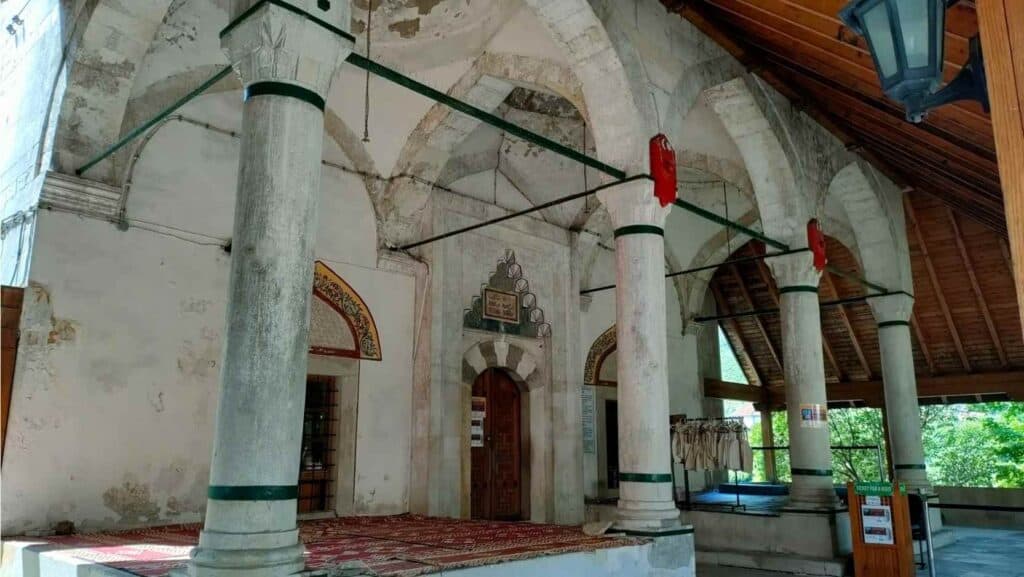
There are a couple of Ottoman-style houses (Bišćevića House, Muslibegović House) in Mostar, out of which the Kajtaz House is the finest example.
Have a look at the Cejvan-ćehaja’s Mosque, constructed in 1552, the oldest surviving monument of Ottoman rule in Herzegovina.
Outside the cobble-stoned old city, you get to the renovated old town, where you can walk along the Braće Fejića street with modern shops and restaurants.
The most important mosque of Mostar stands in this part, the Karadoz Beg Mosque, built in 1557.
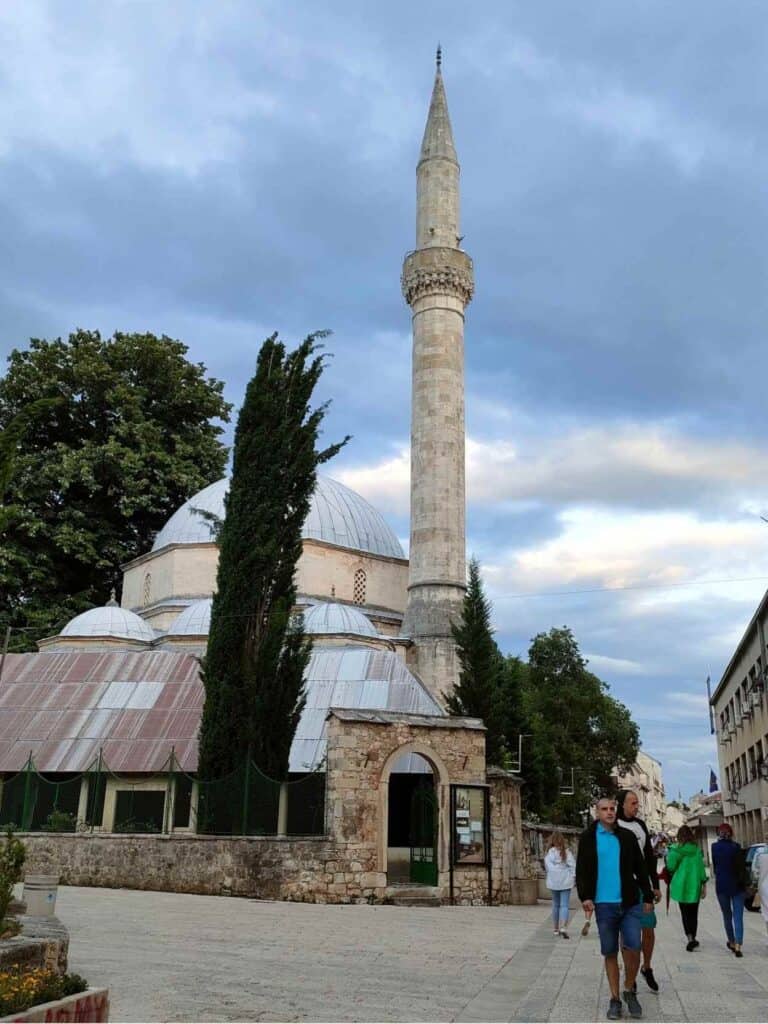
It was also heavily damaged during the war but fully renovated. Behind the mosque is an old Muslim graveyard with beautiful tombstones.
Next to the mosque, the small cemetery full of tombstones with the same year of death during the Bosnian war is heartbreaking, most of them young people. The reason why the cemetery is in the city center is because funerals were often ideal targets for snipers and shellings. So they buried the dead at night, and only a few people were present….
Directly opposite the mosque is the newest museum in Mostar, the Museum of War and Genocide Victims 1992–1995. It is a must-see if you want to understand more about the Bosnian war that is inseparable from Mostar’s and the country’s history. The war’s scars are visible not only in the war-damaged building but also in most people’s minds.
Walking further, you soon reach the Musala Square (Trg Musala) and Musala Bridge, from where you also have a nice view of the Neretva River (not the Old Bridge, though). The Musala Bridge is commonly known by its former name, Tito’s Bridge.
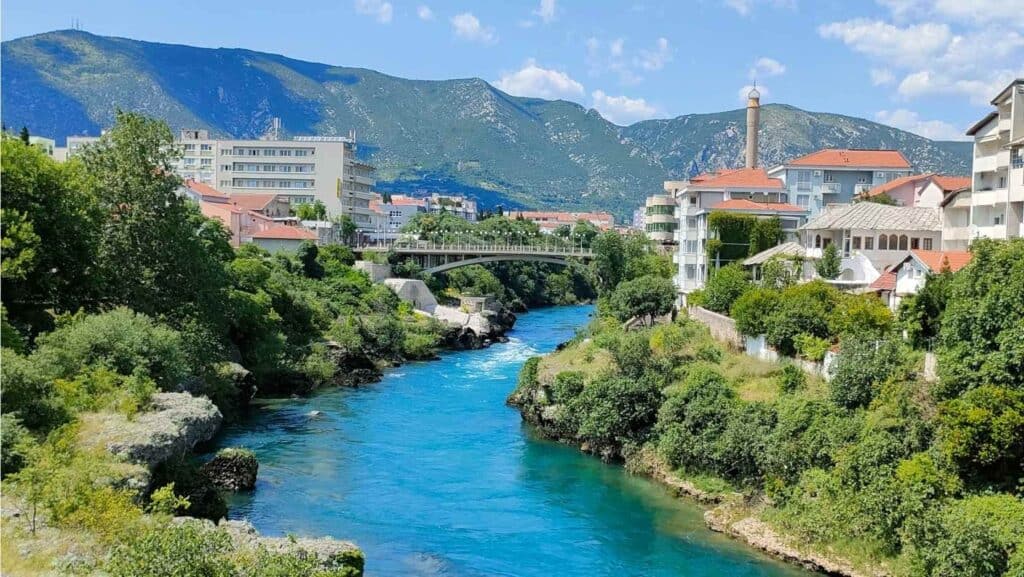
The Alekse Šantića was the street that marked the frontline dividing the Croatian and Bosnian forces and saw some of the most intensive fighting of the whole war. Several buildings along that still bear the signs of bombardments and have not been renovated due to lack of money.
Along the former frontline stands the elegant yellow Gimnazija “Aleksa Šantić”, built in 1896 during the Austro-Hungarian rule with Moorish architectural elements. It was once the most prestigious secondary school that welcomed students from all ethnic groups: Serbs, Croats, Bosniaks, and Jews. Renovations finished in 2009, but except for some classes, Bosnian Croat and Bosniak students study based on two national separate secondary school curricula. It was one of the first schools in Bosnia and Herzegovina that integrated different ethnic groups.
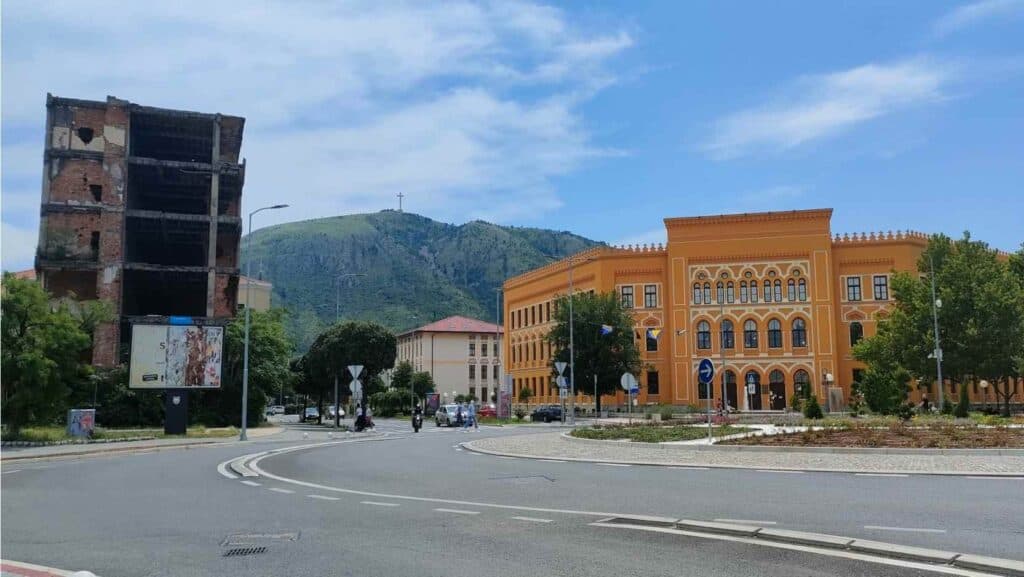
Interestingly, the United World College in Mostar occupies the third floor, opened in 2006 by Queen Noor of Jordan as part of the United World College to support the post-war recovery of Bosnia and Herzegovina. Here the students come from all ethnic groups from all over the country and abroad, live and study together.
It is worth discovering the part outside the old city as well.
Just at the edge of the Park Zrinjevac stands an enormous, abandoned ten-story building and former bank that everyone knows as the Sniper Tower, used as such during the 1990s siege.
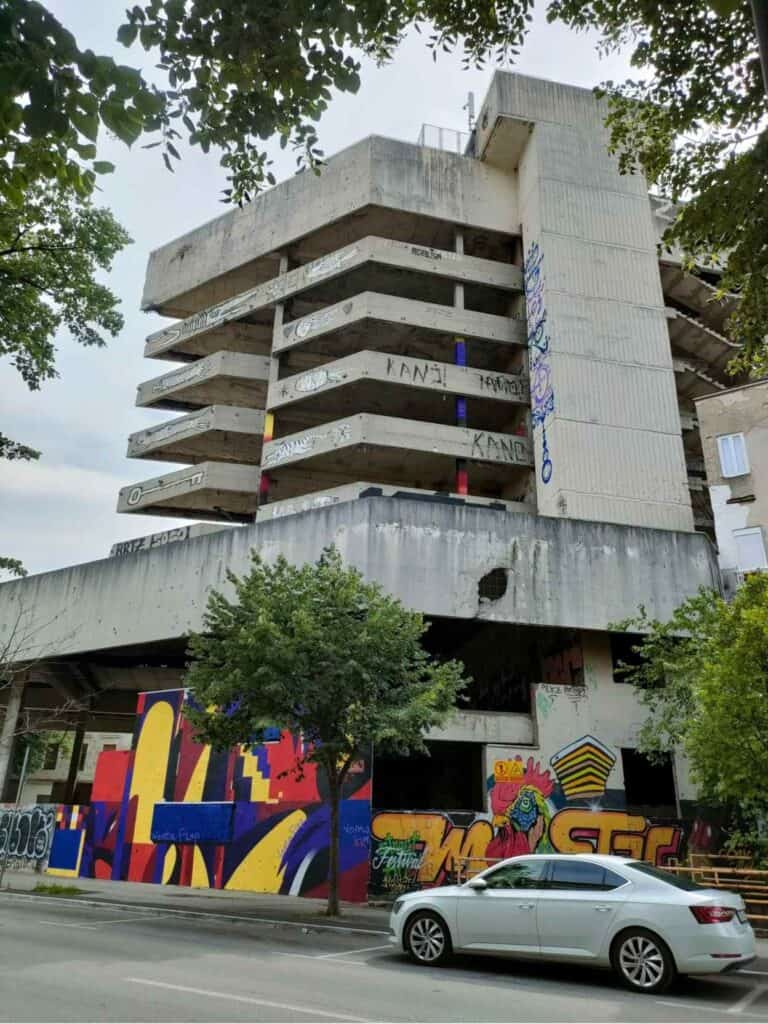
If you have time and are interested in a truly socialist monument, the Partisan Memorial is a 20-minute walk from Park Zrinjevac. It was built in 1965 in honor of the Yugoslav partisans who died during WWII fighting against the Independent State of Croatia, a puppet state of Nazi Germany and fascist Italy.
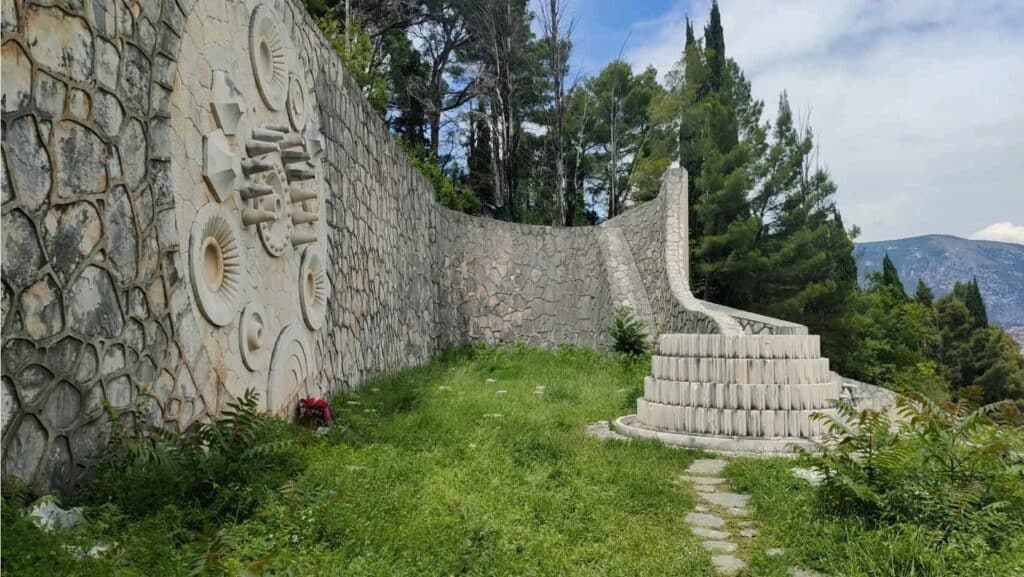
Josip Broz Tito inaugurated the monument. However, the memorial has lately been vandalized by neofascist groups. In 2022 nationalist graffiti appeared at the cemetery entrance, including swastikas, Ustaše symbols, and anti-Bosniak slurs.
You can spend a whole day only in Mostar going on a local tour, visiting the Old Town, taking countless photos of the Old Bridge, and tasting the Herzegovinian cuisine. But I recommend staying there overnight to see the city in lights without the crowds of people when the city shows its best side.

